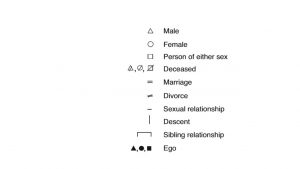10 Social Structures: Kinship and Marriage
Taylor Livingston
Learning Objectives
- Differentiate between unilateral and cognatic systems of kinship.
- Explain postmartial residence patterns.
- Apply kinship theory and methods to current social issue.
Social Structure: Kinship
In the winter of 2016, Dani Shapiro, a writer, took an over-the-counter DNA test, which reveals your ancestry. Little did she know that this test would change her life. The results revealed half of Shapiro’s DNA clustered with those of Eastern European Ashkenazi Jews, while the remaining half clustered with those of Western European heritage. The results shocked Shapiro as both her parents were practicing Orthodox Jews with Eastern European Ashkenazi heritage. She knew everything about her family, as most of her writing was memoir (Shapiro, 2019). How could she have a DNA heritage different than her parents and a cousin she knew nothing about?
Full podcast episode:
Over the next years, as Shapiro learned about her genetic heritage, she learned something anthropologists have long known; kinship often has little to do with genetics.
Circles and Triangles
From the beginning of the discipline of Anthropology until the 1980s, the first thing a cultural anthropologist would do upon arriving to live and study with a group of people was to learn their kinship. Kinship, culturally defined relationships between persons based on descent (actual or presumed) or marriage, is a way all societies organize themselves. To survive, humans must be able to construct and maintain cohesive groups that work together to solve problems: How will we eat? Where will we live? Where can we get water? Kinship can be used to form discrete, stable groups that persist over time. However, how societies do this organizing of stable groups varies considerably. Knowing a society’s kinship system, who was related to whom and what relationship this entailed, opened up the worldview of the group. Kinship relations entail the idea of rights and obligations, as well as ideas about how humans are created (Stone and King, 2019). In certain societies, kinship connections form the basis of their social, economic, and political structure.
Anthropologists would talk to people and map out their kinship chart, a diagram of relations. Kinship charts have very specific lexicons the most basic of which is a circle to represent females and a triangle to represent males. There are also terms to signify the exact type of relationship. People who are related through marriage are called affinal kin, while people who are thought to be related through biology are called consanguineal (from the Latin for blood) kin. A third category, fictive kin, recognizes that people we treat as if they were related to use by blood or marriage are not always. For example, if your mother has a close female friend, you may refer to her as “Aunt Linda,” although she is not biologically related to you or your mother. In addition to terms, kinship systems also reveal information about marriage and residence patterns.
Kinship was so important to anthropology, that its study arguably started the discipline with Lewis Henry Morgan’s Systems of Consanguinity and Affinity of the Human Family published in 1871. Morgan was a businessman who was very interested in the ways of life of the Iroquois, one of the Indigenous groups of his home state of New York, so much so that he made a life-long study of them. He noticed that their method of naming kin was very different from our own. The word for “father,” for example, was applied not only to the direct male parent, (like our kinship system) but also to other male relatives, like someone who we would call “uncle.” The Iroquois term for “mother” was also used in a similar way. Morgan thought this so curious that he began collecting “kinship terminologies” (what people call those related through descent) of various groups throughout history and around the world. From his studies, he compiled an idea of kinship inspired by the theory of evolution. Morgan thought societies progressed through stages of descent: matrilineal, tracing descent through the mother; patrilineal, tracing descent through the father; then, to a having no kinship system. He believed the earliest known kinship system of humans was matrilineal, similar to the Iroquois and represented a time of “primitive promiscuity” where children referred to all male kin as “father” because they did not know who was their biological father. Next, humans “advanced” to monogamy, which brought about the practice of patrilineal decent and specific kin terms for relatives. The final most advanced stage was like the Ancient Romans who Morgan thought did not have a kin system (Fox, 1974).
It should be noted that there are multiple flaws with Morgan’s theory. First, as noted elsewhere in this text, evolution is not “progression.” There is no endpoint. It’s random changes in allele frequencies that make certain individuals better adapted to that environment at that time. These individuals live long enough to reproduce and pass on these random changes to their offspring. Further, societies and cultures do not progress. Every society and culture that exists today and has ever existed is just as “progressed” and “advanced” as another. Believing otherwise is an example of ethnocentrism. Second, Ancient Rome most definitely had a kinship system—the society was thought to be started by twin brothers! You have to have a kinship system to have a notion of twins and brothers. Ancient Roman kinship was patrilineal and centered on the nuclear family. Finally, and most seriously, Morgan’s theories are an example of Social Darwinism. This misguided line of thinking incorrect (see first point) applies Darwin’s theory of evolution by natural selection to different groups of humans. This is not only ethnocentric, it is racist. There is a reason the Ancient Roman society was considered the most advanced—Western society, is modeled on Roman principles. Additionally, Ancient Romans were considered white—just like Morgan. It is also not a coincidence the Iroquois were considered the least advanced, as this and other Indigenous groups were in a battle with the United States government over land rights and sovereignty. Portraying Indigenous groups as less advanced provides a justification for settler colonialism and genocide.
But Morgan was correct about different types of kinship systems. In addition to the two he identified, patrilineal and matrilineal, which trace descent through one line of descent only, called a lineage, there is cognatic decent. Cognatic descent traces descent through both the mother and father unlike the other systems that are unilineal, meaning descent is traced through only the mother or the father. Different forms of descent reveal which relationships are most important in a culture. They also often reveal who has more power, males or female, but this is not always the case, and which lineage holds property. for example, in matrilineal societies, the mother's brother is often the most important in the member of the lineage. While it is true that in matrilineal societies women tend to have more power than in patrilineal societies, there are no matriarchal societies where women rule, but there are patriarchal societies. It is more correct to see kinship systems as ways resources are controlled and past down. In patrilineal groups, property is owned and passed down through male relatives, while it matrilineal, through the female lineage. Property is passed down through both the male and female lineages in cognatic descent groups. A lineage who collectively owns property, resources, rights, or power is called a corporate group.
Kinship Chart–Graphical representations of kinship
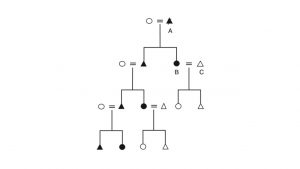

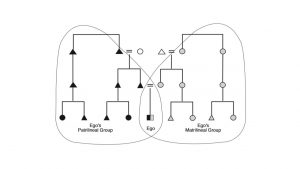
Family and Marriage
A family can be defined as the smallest group of individuals who see themselves as connected to one another. They are usually part of larger kinship groups, but with whom they may not interact on a daily basis. Families tend to reside together and share economic opportunities and other rights and responsibilities. Family rights and responsibilities are a significant part of understanding families and how they work. In the United States, for example, minor children have a right to be supported materially by their parents or other legal guardians. Parents have a responsibility to support and nurture their children. Family members who reside together are called households. A household may include larger kinship groups who think of themselves as separate but related families. Households may also include non-family or kin members, or could even consist exclusively of non-related people who think of themselves as family.
Families, and kinship in general, are about relationships. Relationships are defined by status and roles. Status is any culturally-designated position a person occupies in a particular setting. Role is the set of behaviors expected of an individual who occupies a particular status. For example, a person may have the status of “mother.” The role associated with the status, the behaviors expected of a “mother,” would include caring for children. Cross-culturally, the basic unit of the family is mother and child.
Families can grow through the addition of people through birth, adoption, or marriage. Marriage is defined as a long term, symbolically marked, sexual union and social process. Though marriage exists in all cultures, what these look like varies from culture to culture. There are two types of marriage: Endogamous marriage: Marriage preference for people in a group to marry a member of that group. Exogamous marriage: Marriage preference for people to marry someone outside of a certain group they are a member of. Exogamous marriages are used to establish social connections to other groups, while endogamous marriages are generally used to consolidate power (see Queen Victoria’s, queen of England from 1876-1901 kinship chart below; note how the current Queen of England, Elizabeth II and her husband Prince Philip are cousins).
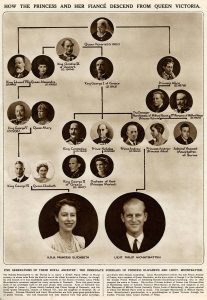
Cultures vary in how many spouses are allowed. Monogamy, the norm in our only culture, only allows one partner/spouse. Polygamous marriages allow more than one spouse/partner. Polygamous marriages vary in whether they allow more women or men. Polygynous marriage is the marriage of one man to multiple women, while polyandrous marriage is the marriage of one women to multiple men. Polyandrous marriage is very rare and often includes the marriage of brothers to one woman. This is called fraternal polyandry and is common in some areas of Tibet where arable land is rare. This marriage arrangement allows large parcels of arable land to be kept in the family, which would not the case in monogamy, as successive generations would receive smaller and smaller plots of land.
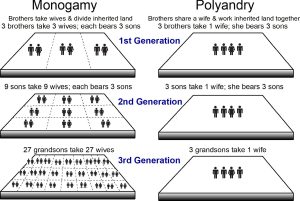
Residence Patterns
Cultures also vary in where married people should live. There are several different types of postmartial residence patterns:
Types of Postmarital Residence Patterns:
- Matrilocal (uxorilocal) – couple lives with or near bride’s kin
- Patrilocal (virilocal) – couple lives with or near groom’s kin
- Ambilocal – couple can choose to live with or near kin of either side
- Neolocal – couple moves to a new household or location, living with neither side’s kin
- Natolocal – wife and husband remain with their own natal kin
- Avunculocal – couple moves to or near the residence of the groom’s mother’s brother(s)
Patrilocal residence is most common in patrilineal societies, while matrilocal, natolocal, and avunculocal residence patterns are most common in matrilineal societies. Natolocal residence patterns are the rarest form of postmartial residence patterns. The Mosuo, an ethnic Chinese community that lives in Yunnan province, practice natolocal residence patterns as part of their “walking marriages.” In this arrangement, spouses do not live together, but only visit each other in the evenings. Husbands live with their female kin and wives with their female kin. Any children conceived in the marriage live with the mother. Learn more about this group and their “walking marriages” in the clip below. Note, though the clip claims the Mouso are a matriarchy, this is not the case. The oldest male relative and the oldest female relative have the same status and power.
The New Kinship Studies
Today, kinship studies have changed from Lewis Henry Morgan’s time of studying the kinship patterns of one society. Today, kinship studies tend to focus on new ideas of relatedness, from studies of adoption, changing ideas of marriage, including gay marriage, and studies of reproductive technologies–new ways of creating families including the use of in vitro fertilization and surrogacy, particularly in the instance of international adoption and surrogacy. Studies of kinship also include applied setting from the unraveling of family secrets, as mentioned in the beginning of the chapter, to the solving of cold case crimes. In this instance, genetic information obtained from ancestry websites are compared to the DNA evidence from crime scenes, then using knowledge of relatedness and kinship to identify potential suspects. A recent solved cold case using this technology and kinship studies was the case of the Golden State Killer. The Golden State Killer terrorized Central and Southern California from the 1970s-1980s. However, he was identified and arrested in 2018 through the use of ancestry DNA from a distant male relative uploaded to the private ancestry database MyHeritage. Though not without controversy as many DNA ancestry companies do not ask their users to consent to their personal genetic information being used by law enforcement, the technology and kinship know-how has been used to solve numerous cold cases.
Key Takeaways
- Kinship studies are all about understanding social relationships, obligations, and responsibilities in a culture.
- Unilineal descent systems, like matrilineal and patrilineal descent, trace relatives through the mother or father’s side of the family.
- Congnatic descent traces relations through both mother and father.
- There are several different post martial residence patterns including patrilocal, matrilocal, avuncolocal, neolocial, natolocal, and ambilocal.
- Today, the study of kinship can be applied to solving crimes as well as finding relatives.
culturally defined relationships between persons based on descent (actual or presumed) or marriage
a diagram of relations
relations through marriage
relations who are related through biology
relations that are not through biology or marriage, but are still considered family
tracing descent through the mother
tracing descent through the father
mother, father, and their offspring
a belief that race is a fundamental determinant of human traits and capacities and that racial differences produce an inherent superiority of a particular race (from Merriam Webster)
a form of colonialism that seeks to replace the original population of the colonized territory with a new society of settlers
the target killing of a social groups of people because of their beliefs, culture, gender, sexuality, ability status, race, or ethnicity
term used to describe any form of descent from a common ancestor
descent through both the mother and father
racing descent through either the mother or father
maternal uncle, who in some matrilineal societies has the most power
lineage or descent group that collectively hold property
family members that live together
culturally-designated position a person occupies in a particular setting
set of behaviors expected of an individual who occupies a particular status
long term, symbolically marked, sexual union and social process
marriage to someone in your social group
marriage to someone outside your social or descent group
A form of dyadic relationship in which an individual has only one sexual partner for some interval of time such as a breading season or lifetime. Serial monogamy involves a succession of monogamous sexual relationships.
marriages that allow for more than one spouse/partner
A single adult male defends a group of females from other males and, while his tenure lasts, enjoys exclusive mating access to those females. This is sometimes referred to as a harem‐based mating system. Primates with this pattern live often live in one-male multi-female groups, and the females tend to be related since they stay in their natal group (philopatric) and males move out upon reaching sexual maturity.
A form of polygamy in which a female mates with two or more males at the same time. This is quite rare among humans, but when it occurs the males are commonly brothers.
post martial residence pattern where the couple resides with the bride's kin
postmartial residence pattern where the couple resides with or near the groom's family
postmartial residence pattern where the couple can choose to with with or near kin of either side
postmartial residence pattern where the couple moves to a new household or location
postmartial residence pattern where the couple remain with their natal kin
postmartial residence pattern where the couple moves in or near the groom's mother's brother
postmartial residence pattern and marriage form among the Mouso where spouses do not live together, but remain with their natal kin and only visit each other in the evenings.
In vitro fertilisation is a process of fertilisation where an egg is combined with sperm outside the body
arrangement whereby a woman agrees to bear a child for another person or persons
crimes that are unsolved and where there are no leads on who committed the crime for several years

